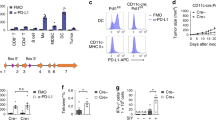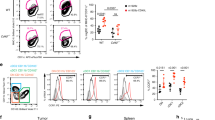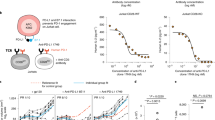Abstract
Regulatory T cells (Treg cells) suppress autoreactive immune responses and limit the efficacy of tumor vaccines; however, it remains a challenge to selectively eliminate or inhibit Treg cells. In this study, the zinc-finger A20, a negative regulator of the Toll-like receptor and tumor necrosis factor receptor signaling pathways, was found to play a crucial part in controlling the maturation, cytokine production and immunostimulatory potency of dendritic cells (DCs). A20-silenced DCs showed spontaneous and enhanced expression of costimulatory molecules and proinflammatory cytokines and had different effects on T cell subsets: they inhibited Treg cells and hyperactivated tumor-infiltrating cytotoxic T lymphocytes and T helper cells that produced interleukin-6 and tumor necrosis factor-α and were refractory to Treg cell–mediated suppression. Hence, this study identifies A20 as an antigen presentation attenuator in control of antitumor immune responses during both the priming and the effector phases and provides a strategy to overcome Treg cell–mediated suppression in an antigen-specific manner, reducing the need to directly target Treg cells.
This is a preview of subscription content, access via your institution
Access options
Subscribe to this journal
Receive 12 print issues and online access
$209.00 per year
only $17.42 per issue
Buy this article
- Purchase on Springer Link
- Instant access to full article PDF
Prices may be subject to local taxes which are calculated during checkout






Similar content being viewed by others
References
Banchereau, J. & Steinman, R.M. Dendritic cells and the control of immunity. Nature 392, 245–252 (1998).
Rosenberg, S.A., Yang, J.C. & Restifo, N.P. Cancer immunotherapy: moving beyond current vaccines. Nat. Med. 10, 909–915 (2004).
Rosenberg, S.A. et al. Tumor progression can occur despite the induction of very high levels of self/tumor antigen-specific CD8· T cells in patients with melanoma. J. Immunol. 175, 6169–6176 (2005).
Boon, T., Coulie, P.G., Van den Eynde, B.J. & van der Bruggen, P. Human T cell responses against melanoma. Annu. Rev. Immunol. 24, 175–208 (2006).
Evel-Kabler, K. & Chen, S.Y. Dendritic cell–based tumor vaccines and antigen presentation attenuators. Mol. Ther. 13, 850–858 (2006).
Sakaguchi, S. Naturally arising Foxp3-expressing CD25·CD4· regulatory T cells in immunological tolerance to self and non-self. Nat. Immunol. 6, 345–352 (2005).
Fontenot, J.D. & Rudensky, A.Y. A well adapted regulatory contrivance: regulatory T cell development and the forkhead family transcription factor Foxp3. Nat. Immunol. 6, 331–337 (2005).
Woo, E.Y. et al. Regulatory CD4·CD25· T cells in tumors from patients with early-stage non-small cell lung cancer and late-stage ovarian cancer. Cancer Res. 61, 4766–4772 (2001).
Curiel, T.J. et al. Specific recruitment of regulatory T cells in ovarian carcinoma fosters immune privilege and predicts reduced survival. Nat. Med. 10, 942–949 (2004).
Wang, H.Y. et al. Tumor-specific human CD4· regulatory T cells and their ligands: implications for immunotherapy. Immunity 20, 107–118 (2004).
Zou, W. Regulatory T cells, tumour immunity and immunotherapy. Nat. Rev. Immunol. 6, 295–307 (2006).
Shimizu, J., Yamazaki, S. & Sakaguchi, S. Induction of tumor immunity by removing CD25·CD4· T cells: a common basis between tumor immunity and autoimmunity. J. Immunol. 163, 5211–5218 (1999).
Sutmuller, R.P. et al. Synergism of cytotoxic T lymphocyte–associated antigen 4 blockade and depletion of CD25· regulatory T cells in antitumor therapy reveals alternative pathways for suppression of autoreactive cytotoxic T lymphocyte responses. J. Exp. Med. 194, 823–832 (2001).
Dannull, J. et al. Enhancement of vaccine-mediated antitumor immunity in cancer patients after depletion of regulatory T cells. J. Clin. Invest. 115, 3623–3633 (2005).
Quezada, S.A., Peggs, K.S., Curran, M.A. & Allison, J.P. CTLA4 blockade and GM-CSF combination immunotherapy alters the intratumor balance of effector and regulatory T cells. J. Clin. Invest. 116, 1935–1945 (2006).
Stephens, G.L. et al. Engagement of glucocorticoid-induced TNFR family–related receptor on effector T cells by its ligand mediates resistance to suppression by CD4·CD25· T cells. J. Immunol. 173, 5008–5020 (2004).
Maker, A.V., Attia, P. & Rosenberg, S.A. Analysis of the cellular mechanism of antitumor responses and autoimmunity in patients treated with CTLA-4 blockade. J. Immunol. 175, 7746–7754 (2005).
Attia, P. et al. Autoimmunity correlates with tumor regression in patients with metastatic melanoma treated with anti-cytotoxic T lymphocyte antigen-4. J. Clin. Oncol. 23, 6043–6053 (2005).
Suntharalingam, G. et al. Cytokine storm in a phase 1 trial of the anti-CD28 monoclonal antibody TGN1412. N. Engl. J. Med. 355, 1018–1028 (2006).
Lee, E.G. et al. Failure to regulate TNF-induced NF-κB and cell death responses in A20-deficient mice. Science 289, 2350–2354 (2000).
Boone, D.L. et al. The ubiquitin-modifying enzyme A20 is required for termination of Toll-like receptor responses. Nat. Immunol. 5, 1052–1060 (2004).
Wertz, I.E. et al. De-ubiquitination and ubiquitin ligase domains of A20 downregulate NF-κB signalling. Nature 430, 694–699 (2004).
Sarma, V. et al. Activation of the B cell surface receptor CD40 induces A20, a novel zinc finger protein that inhibits apoptosis. J. Biol. Chem. 270, 12343–12346 (1995).
Saitoh, T. et al. A20 is a negative regulator of IFN regulatory factor 3 signaling. J. Immunol. 174, 1507–1512 (2005).
Bloom, M.B. et al. Identification of tyrosinase-related protein 2 as a tumor rejection antigen for the B16 melanoma. J. Exp. Med. 185, 453–459 (1997).
van Elsas, A. et al. Elucidating the autoimmune and antitumor effector mechanisms of a treatment based on cytotoxic T lymphocyte antigen-4 blockade in combination with a B16 melanoma vaccine: comparison of prophylaxis and therapy. J. Exp. Med. 194, 481–489 (2001).
Siegel, S., Wagner, A., Schmitz, N. & Zeis, M. Induction of antitumour immunity using survivin peptide–pulsed dendritic cells in a murine lymphoma model. Br. J. Haematol. 122, 911–914 (2003).
Ambrosini, G., Adida, C. & Altieri, D.C. A novel anti-apoptosis gene, survivin, expressed in cancer and lymphoma. Nat. Med. 3, 917–921 (1997).
Allouche, M. et al. Phorbol myristate acetate induces both high affinity and low affinity interleukin-2 receptors on a pre-B leukemic cell line. Leuk. Res. 14, 353–361 (1990).
Prasad, S.J. et al. Dendritic cells loaded with stressed tumor cells elicit long-lasting protective tumor immunity in mice depleted of CD4·CD25· regulatory T cells. J. Immunol. 174, 90–98 (2005).
Evel-Kabler, K., Song, X.T., Aldrich, M., Huang, X.F. & Chen, S.Y. SOCS1 restricts dendritic cells' ability to break self tolerance and induce antitumor immunity by regulating IL-12 production and signaling. J. Clin. Invest. 116, 90–100 (2006).
Shen, L., Evel-Kabler, K., Strube, R. & Chen, S.Y. Silencing of SOCS1 enhances antigen presentation by dendritic cells and antigen-specific anti-tumor immunity. Nat. Biotechnol. 22, 1546–1553 (2004).
Overwijk, W.W. Breaking tolerance in cancer immunotherapy: time to ACT. Curr. Opin. Immunol. 17, 187–194 (2005).
Pasare, C. & Medzhitov, R. Toll pathway–dependent blockade of CD4·CD25· T cell–mediated suppression by dendritic cells. Science 299, 1033–1036 (2003).
Kubo, T. et al. Regulatory T cell suppression and anergy are differentially regulated by proinflammatory cytokines produced by TLR-activated dendritic cells. J. Immunol. 173, 7249–7258 (2004).
Yamazaki, S. et al. Direct expansion of functional CD25+CD4+ regulatory T cells by antigen-processing dendritic cells. J. Exp. Med. 198, 235–247 (2003).
Fehervari, Z. & Sakaguchi, S. Control of Foxp3+ CD25+CD4+ regulatory cell activation and function by dendritic cells. Int. Immunol. 16, 1769–1780 (2004).
Ramirez-Montagut, T. et al. Glucocorticoid-induced TNF receptor family related gene activation overcomes tolerance/ignorance to melanoma differentiation antigens and enhances antitumor immunity. J. Immunol. 176, 6434–6442 (2006).
Valencia, X. et al. TNF downmodulates the function of human CD4·CD25hi T regulatory cells. Blood 108, 253–261 (2006).
King, I.L. & Segal, B.M. Cutting edge: IL-12 induces CD4+CD25− T cell activation in the presence of T regulatory cells. J. Immunol. 175, 641–645 (2005).
Thornton, A.M., Donovan, E.E., Piccirillo, C.A. & Shevach, E.M. Cutting edge: IL-2 is critically required for the in vitro activation of CD4+CD25+ T cell suppressor function. J. Immunol. 172, 6519–6523 (2004).
Thornton, A.M. & Shevach, E.M. Suppressor effector function of CD4+CD25+ immunoregulatory T cells is antigen nonspecific. J. Immunol. 164, 183–190 (2000).
Vu, M.D. et al. OX40 costimulation turns off Foxp3+ Treg cells. Blood 110, 2501–2510 (2007).
So, T. & Croft, M. Cutting edge: OX40 inhibits TGF-β– and antigen-driven conversion of naive CD4 T cells into CD25+Foxp3+ T cells. J. Immunol. 179, 1427–1430 (2007).
Korn, T. et al. Myelin-specific regulatory T cells accumulate in the CNS but fail to control autoimmune inflammation. Nat. Med. 13, 423–431 (2007).
Schroers, R. & Chen, S.Y. Lentiviral transduction of human dendritic cells. Methods Mol. Biol. 246, 451–459 (2004).
Acknowledgements
We thank R. Dutton at the Trudeau Institute for the B6-OVA melanoma cell line. We thank B. Hong, B. Liu, M. Aldrich, N. Lapteva, and A. Sharabi in the lab for technical assistance and valuable suggestions. We also thank M. Brenner, H. Heslop, C. Rooney, R.F. Wang and other colleagues for helpful suggestions and assistance. This work was supported by grants from the US National Institutes of Health (R01CA90427, R01CA116677 and R01AI68472 to S.-Y.C. and R01 CA100841 to X.F.H.), and the Leukemia and Lymphoma Society Specialized Center of Research Program.
Author information
Authors and Affiliations
Contributions
X.-T.S. and K.E.-K. designed and performed in vitro and in vivo experiments. L.S., L.R. and X.F.H. performed in vitro and in vivo experiments. S.-Y.C. designed this study, supervised this project and wrote the paper.
Corresponding author
Ethics declarations
Competing interests
S.-Y.C. has an equity interest in ImmunoVac, Inc., which licensed this technology of the modulation of negative immune regulators and applications for immunotherapy.
Supplementary information
Supplementary Text and Figures
Supplementary Figs. 1–7 and Supplementary Methods (PDF 159 kb)
Rights and permissions
About this article
Cite this article
Song, XT., Kabler, K., Shen, L. et al. A20 is an antigen presentation attenuator, and its inhibition overcomes regulatory T cell–mediated suppression. Nat Med 14, 258–265 (2008). https://doi.org/10.1038/nm1721
Received:
Accepted:
Published:
Issue Date:
DOI: https://doi.org/10.1038/nm1721
This article is cited by
-
Crosstalk between cancer-associated fibroblasts and immune cells in the tumor microenvironment: new findings and future perspectives
Molecular Cancer (2021)
-
Biomechanical forces enhance directed migration and activation of bone marrow-derived dendritic cells
Scientific Reports (2021)
-
A20 promotes melanoma progression via the activation of Akt pathway
Cell Death & Disease (2020)
-
The silencing of indoleamine 2,3-dioxygenase 1 (IDO1) in dendritic cells by siRNA-loaded lipid nanoparticles enhances cell-based cancer immunotherapy
Scientific Reports (2019)
-
TNFAIP3 genetic polymorphisms reduce ankylosing spondylitis risk in Eastern Chinese Han population
Scientific Reports (2019)



